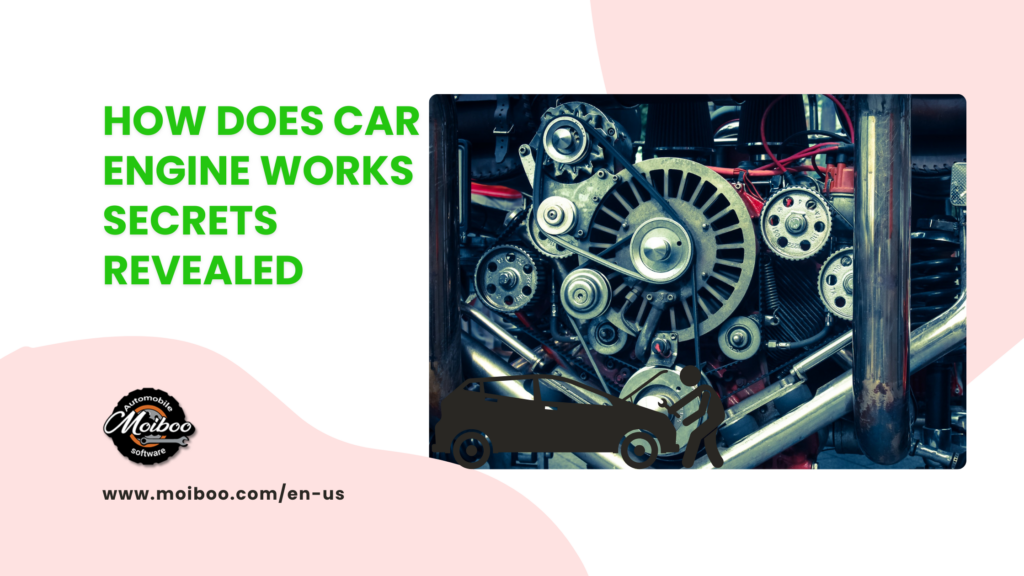Have you ever wondered what makes your car engine works? How does it turn fuel into motion? What are the parts that make it work? If you are curious about these questions, you are in the right place.
In this blog post, we will uncover the secrets of car engines and explain how they work in simple terms. We will also look at the main components that make up a car engine and their roles.

What is a Car Engine?
A car engine is a kind of internal combustion engine that uses fuel (usually gasoline or diesel) to create mechanical energy. It is the core of any vehicle and allows us to travel from one point to another. But how does it do that? By burning fuel inside a cylinder and moving a piston. The piston is attached to a crankshaft, which turns the linear motion of the piston into rotational motion. The crankshaft then powers the wheels of the car through a transmission system.
The Secrets of Car Engines Revealed: The Four-Stroke Cycle
Most car engines use a four-stroke cycle to produce power. This means that each cylinder goes through four stages: intake, compression, power, and exhaust. Let’s see what happens in each stage.
Intake
During the intake stage, the piston moves down and creates a space in the cylinder. This makes the intake valve open and let air and fuel enter the cylinder. The intake valve then shuts and the piston moves up to squeeze the air-fuel mixture.
Compression
During the compression stage, the piston compresses the air-fuel mixture into a small area, increasing its pressure and temperature. This makes the mixture ready for ignition by a spark plug (in gasoline engines) or by heat (in diesel engines).
Power
During the power stage, the spark plug sparks and sets fire to the air-fuel mixture and causes a quick expansion of gas. This pushes the piston down with great force and generates power. The power stage is the only stage that produces work and moves the car.
Exhaust
During the exhaust stage, the piston moves up again and pushes out the burned gas through the exhaust valve. The exhaust valve then closes and the cycle repeats for the next cylinder.
The Secrets of Car Engines Revealed: The Main Components
A car engine has many parts that work together to make it run smoothly and efficiently. Here are some of the main components of a car engine and their functions.
- Cylinder: The cylinder is the place where the fuel combustion takes place. Most car engines have four, six, or eight cylinders arranged in different shapes, such as inline, V, or flat.
- Piston: The piston is a metal piece that moves up and down inside the cylinder. It transfers the pressure from the combustion to the crankshaft.
- Crankshaft: The crankshaft is a long metal shaft that connects the pistons and turns their linear motion into rotational motion. The crankshaft also drives the camshaft, which controls the opening and closing of the valves.
- Valve: The valve is a metal flap that opens and closes to let air and fuel in and out of the cylinder. There are two kinds of valves: intake and exhaust. The intake valve lets air and fuel into the cylinder during the intake stage, while the exhaust valve lets out the burned gas during the exhaust stage.
- Spark plug: The spark plug is a device that creates a spark to ignite the air-fuel mixture in gasoline engines. It is located at the top of the cylinder and is connected to an ignition system that provides electricity.
- Fuel injector: The fuel injector is a device that sprays fuel into the cylinder in a precise amount and timing. It is controlled by a computer that monitors various sensors and adjusts the fuel delivery accordingly.
- Cooling system: The cooling system is a system that regulates the temperature of the engine and prevents it from overheating. It consists of a radiator, a water pump, a thermostat, and a fan. The cooling system circulates coolant (a mixture of water and antifreeze) through the engine and absorbs excess heat. The coolant then passes through the radiator, where it releases heat to the air. The thermostat controls the flow of coolant according to the engine temperature, while the fan helps to cool down the radiator.
- Lubrication system: The lubrication system is a system that provides oil to the moving parts of the engine and reduces friction and wear. It consists of an oil pump, an oil filter, an oil pan, and oil passages. The oil pump draws oil from the oil pan and sends it to the oil filter, where it removes dirt and debris. The oil then flows through the oil passages and reaches the various parts of the engine, such as the pistons, cylinders, valves, and bearings. The oil also helps to cool down the engine by absorbing heat.
Conclusion
Car engines are amazing machines that transform fuel into motion. They use a four-stroke cycle to create power and have many components that work together to make them run smoothly and efficiently. By understanding how car engines work, you can appreciate their design and performance and take better care of your vehicle. If you have any questions or comments, feel free to leave them below. Thank you for reading!
